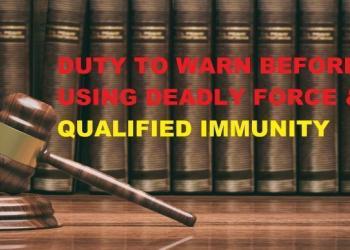
The Use of Deadly force and the Duty to Warn
Qualified immunity from civil liability in a case where deadly force is used is not available in a case where discrepancies in the evidence are better left to a jury to decide. A police officer contemplating the use of deadly force has a duty to warn a suspect when at all practicable to do so under the circumstances.
**UPDATE 05/10/2023: On May 4, 2023, this opinion was withdrawn and a rehearing granted upon resignation from the bench by one of the affirming justices and his replacement with another. A change in justices hearing the case apparently is going to reverse this decision and, as a result, grant Officer Agdeppa qualified immunity. However, this occurrence does not change the basic rule that when at all feasible, an officer should warn a suspect when deadly force is about to be used.**
On October 29, 2018, Los Angeles Police Officers Edward Agdeppa (5’1” and 145 pounds) and Perla Rodriquez (5’5”, 145 pounds) responded to a call at a 24-Hour Fitness gym on Sunset Boulevard in Hollywood where it was reported that a person was trespassing and engaging in disruptive conduct. Upon arrival, staff members complained that a “gentleman” was “a little bit irate,” wasn’t listening, and had already hurt a few gym members. He had also apparently assaulted security personnel. Note: The bulk of this summary is taken from the dissenting opinion; the majority having glossed over much of it.
With their body-worn cameras turned on, the officers contacted a naked Albert Dorsey in the shower area of the men’s locker room, enjoying the music being played on his cellphone. Dorsey was 6’1” tall and weighed 280 pounds (almost as much as both officers combined). Over the next two minutes, Dorsey ignored the officers’ repeated demands that he turn off the music, get dressed, and leave the gym.
He instead walked across the room, admired his naked body in a mirror, danced a bit to the music, and slowly dried himself as he defiantly flipped off Officer Agdeppa. After more than four minutes, Officer Agdeppa decided that enough was enough and approached Dorsey to handcuff him from behind. Dorsey, however, pulled away, and the fight was on. The two officers working together were able to get one handcuff on, but that was it. As Dorsey forcefully resisted, attempts to use arm, finger, and wrist locks were unavailing.
During this struggle, Officer Agdeppa was able to broadcast a request for additional units. Dorsey became more combative, knocking both of the officers’ body-cams off their uniforms, thus ending any visual depictions of the fight. The audio remained on, however, recording over the next “three-or-so minutes” the sounds of frequent bangs, crashes, shouts of pain, and other indicia of a violent confrontation. The officers could be heard yelling at Dorsey to stop resisting.
Officer Agdeppa eventually used his Taser in contact mode, cycling it twice into Dorsey’s chest. Officer Rodriquez fired her Taser into Dorsey’s back, activating it for approximately five seconds. She then activated it a second time. Neither Taser had any effect other than to make Dorsey even more combative. Dorsey began “punching at (the officers’) heads and faces while the handcuff attached to his wrist also swung around and struck” them. Punching Officer Agdeppa in the head and face area, the officer was knocked into a wall and to the ground with such force that he suffered (as it was later determined) a concussion, disorienting him and causing him to drop his Taser. After Officer Rodriguez fired her Taser (still attached to Dorsey’s back) for the third time, Dorsey turned on her, knocking her to the ground. Dorsey then straddled Rodriguez, striking her repeatedly in her face and head as he took her Taser away from her.
Regaining some control of himself, Officer Agdeppa looked up to see Dorsey straddling Officer Rodriquez, “pummeling (her) . . . with a flurry of punches,” as she lay on the floor in the fetal position trying to protect her face and head. Officer Agdeppa later noted in his civil deposition he believed that if allowed to continue, Dorsey’s next blow to Officer Rodriguez’s head could kill her. So Officer Agdeppa drew his firearm and shot Dorsey five times.
In his deposition, Officer Agdeppa stated that he “unholstered and drew [his] service weapon” and “gave Dorsey a verbal warning, stating words to the effect that Dorsey needed to stop.” No such warning could be heard on the still-functioning bodycams. All that could be heard over the “chaotic noise” was a man’s voice shouting something unintelligible just before the shots were fired. It was assumed by the Court, therefore, that no final warning was given. Dorsey succumbed to his wounds.
The Los Angeles Board of Police Commissioners did an internal investigation of the shooting, finding there to be some discrepancies between the officers’ accounts of the confrontation and both the physical evidence and the witness’ accounts (i.e., the two security guards who apparently just stood by and watched). The Commissioners also criticized the officers for failing to merely “disengage” when Dorsey first began to resist and wait until additional assistance arrived. As noted above, Officer Agdeppa suffered a concussion. He also had to have the bridge of his nose stitched up. He was unable to return to work for six months and “had further (undescribed) longer-lasting effects.” Officer Rodriguez suffered a swollen left check and right jaw, abrasions on her ear and hands, and a pulled muscle behind her knee.
Albert Dorsey’s mother, Paulette Smith, sued Officer Agdeppa in federal court alleging the unreasonable use of deadly force. Officer Agdeppa filed a motion for summary judgment, claiming qualified immunity. The district (trial) court denied the motion—noting the discrepancies in the different accounts as to what occurred—and ruled that a jury needed to decide liability, if any. Officer Agdeppa appealed.





